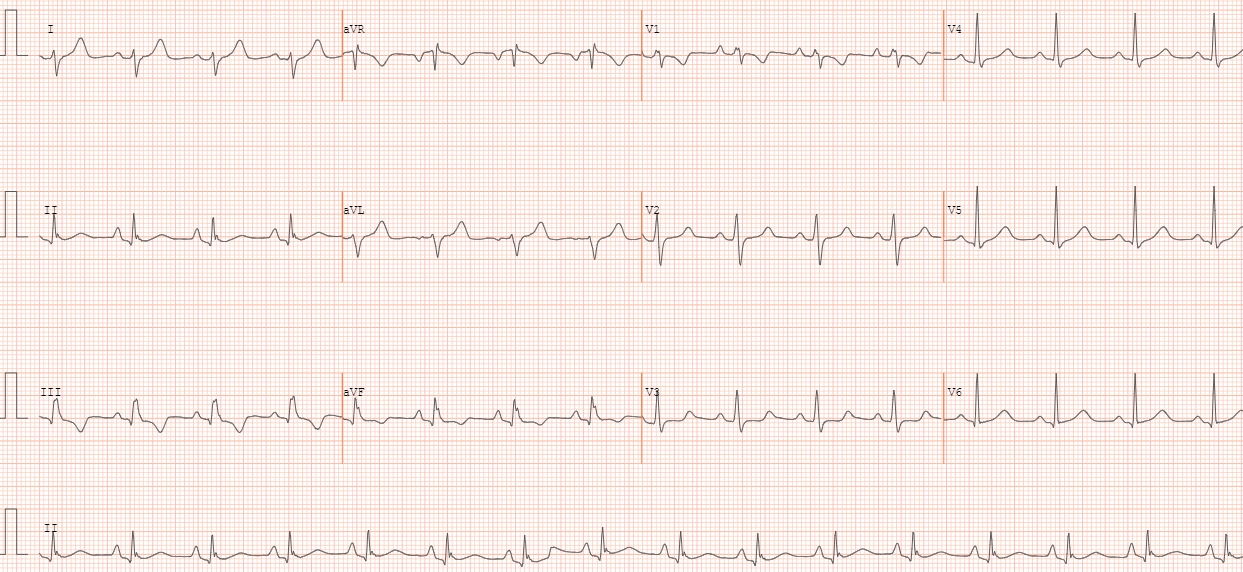ECG in Ebstein’s anomaly of tricuspid valve
ECG in Ebstein’s anomaly of tricuspid valve
 ECG in Ebstein’s anomaly of tricuspid valve
ECG in Ebstein’s anomaly of tricuspid valve
ECG in Ebstein’s anomaly of tricuspid valve showing right axis deviation of QRS, notched R waves in II, III, aVF and V1 suggesting fragmented QRS. Peaked P waves indicate a right atrial abnormality, though the typical voltage criteria for right atrial enlargement (more than 0.25 mV) is not satisfied.
Fragmented QRS occurs in Ebstein’s anomaly due to abnormal conduction in the atrialized right ventricle [1]. A portion of the right ventricle is atrialized because of distal displacement of the septal and posterior leaflets of tricuspid valve. They are also more prone for atrial arrhythmias due to dilated right atrium. They carry a risk of stroke because of potential paradoxical embolism due to intermittent right to left shunting across a patent foramen ovale.
Earlier the descriptions for the QRS abnormality in Ebstein’s anomaly were splintered QRS, fractionated QRS, or second QRS [2]. Intracardiac mapping has demonstrated late depolarization during this period. Fragmented QRS is associated with a higher arrhythmic risk and larger atrialized right ventricular area [3]. They also had more severe tricuspid regurgitation. The extend of fragmented QRS is measured by the number of leads showing the fQRS. QRS duration is longer in those with fQRS. Those with increased QRS duration have a higher mortality on long term follow up after corrective surgery [4].
Wolff-Parkinson-White syndrome can be associated with Ebstein’s anomaly due to accessory atrioventricular bypass tracts and re-entrant supraventricular tachycardia.
References
- Acharya P, Ang JR, Gitler B. Ebstein Anomaly With QRS Fragmentation on Electrocardiogram. J Investig Med High Impact Case Rep. 2017 Jan 1;5(1):2324709616688710.
- Kastor JA, Goldreyer BN, Josephson ME, Perloff JK, Scharf DL, Manchester JH, Shelburne JC, Hirshfeld JW Jr. Electrophysiologic characteristics of Ebstein’s anomaly of the tricuspid valve. Circulation. 1975 Dec;52(6):987-95.
- Park SJ, Chung S, On YK, Kim JS, Yang JH, Jun TG, Jang SY, Lee OJ, Song J, Kang IS, Huh J. Fragmented QRS complex in adult patients with Ebstein anomaly and its association with arrhythmic risk and the severity of the anomaly. Circ Arrhythm Electrophysiol. 2013 Dec;6(6):1148-55.
- Brown ML, Dearani JA, Danielson GK, Cetta F, Connolly HM, Warnes CA, Li Z, Hodge DO, Driscoll DJ; Mayo Clinic Congenital Heart Center. The outcomes of operations for 539 patients with Ebstein anomaly. J Thorac Cardiovasc Surg. 2008 May;135(5):1120-36, 1136.e1-7.

